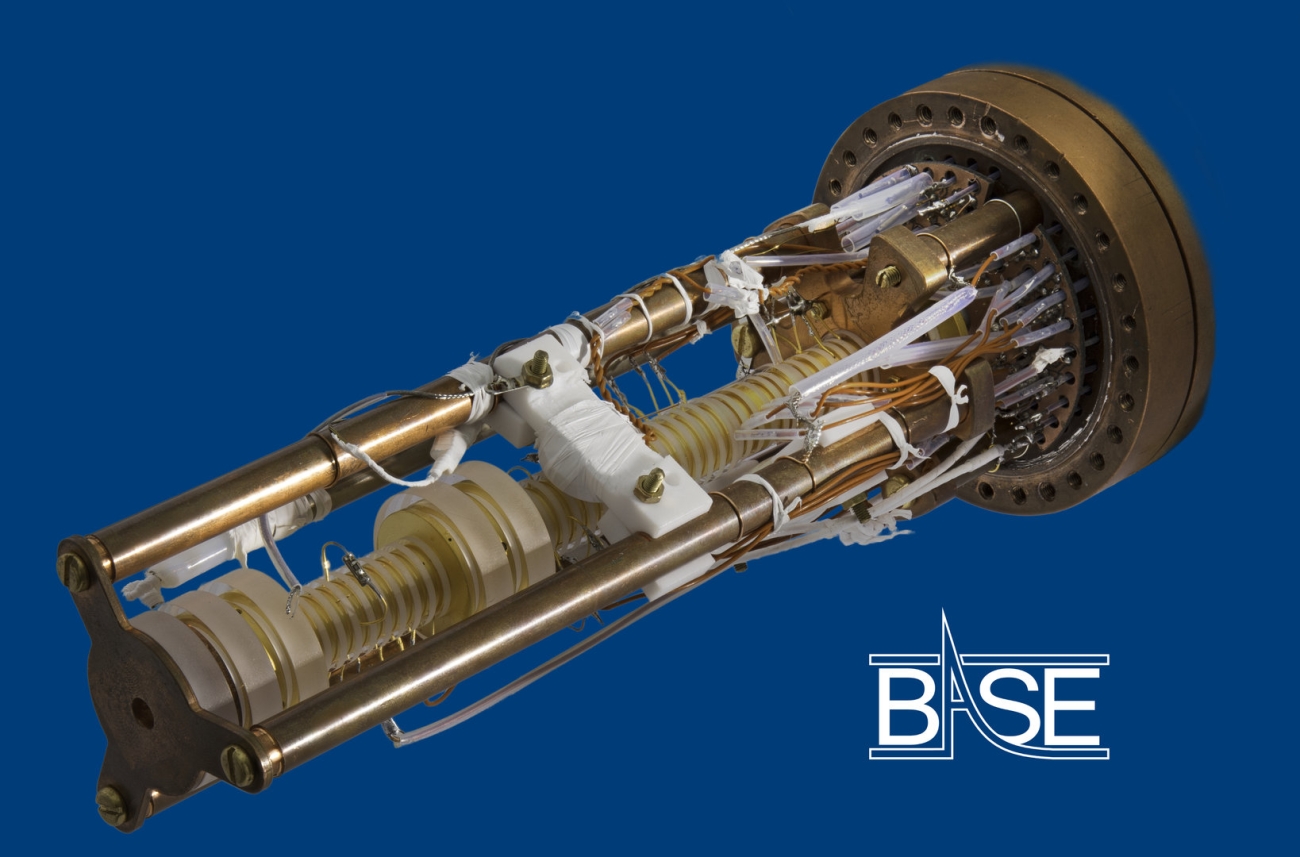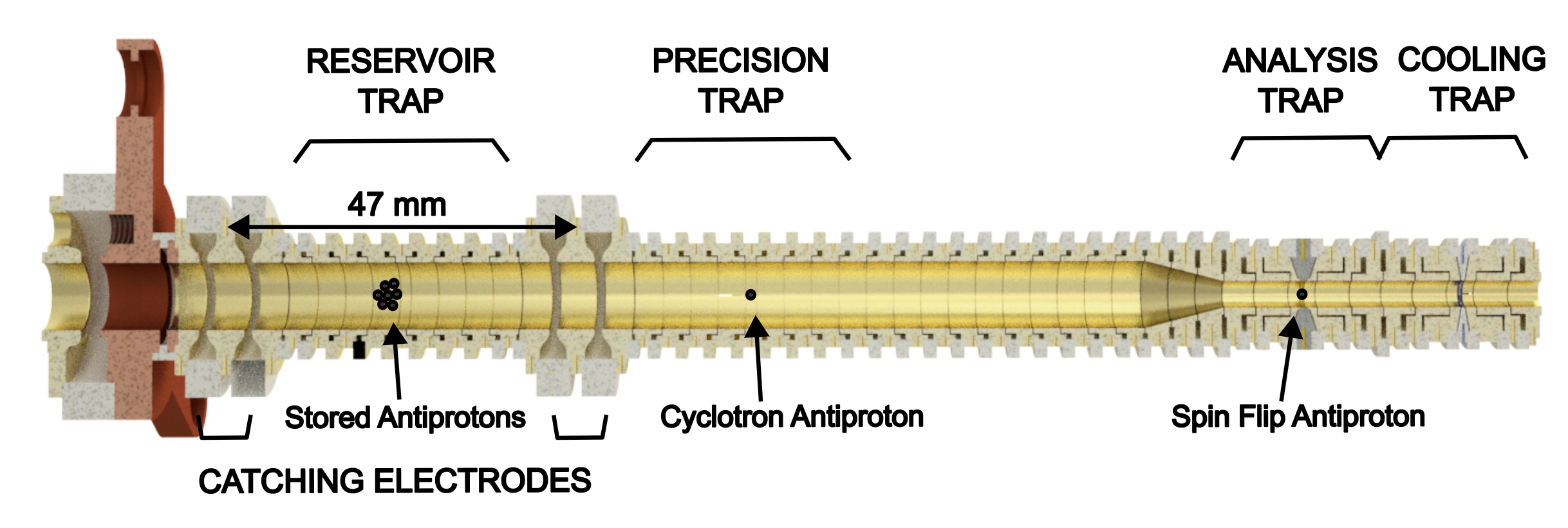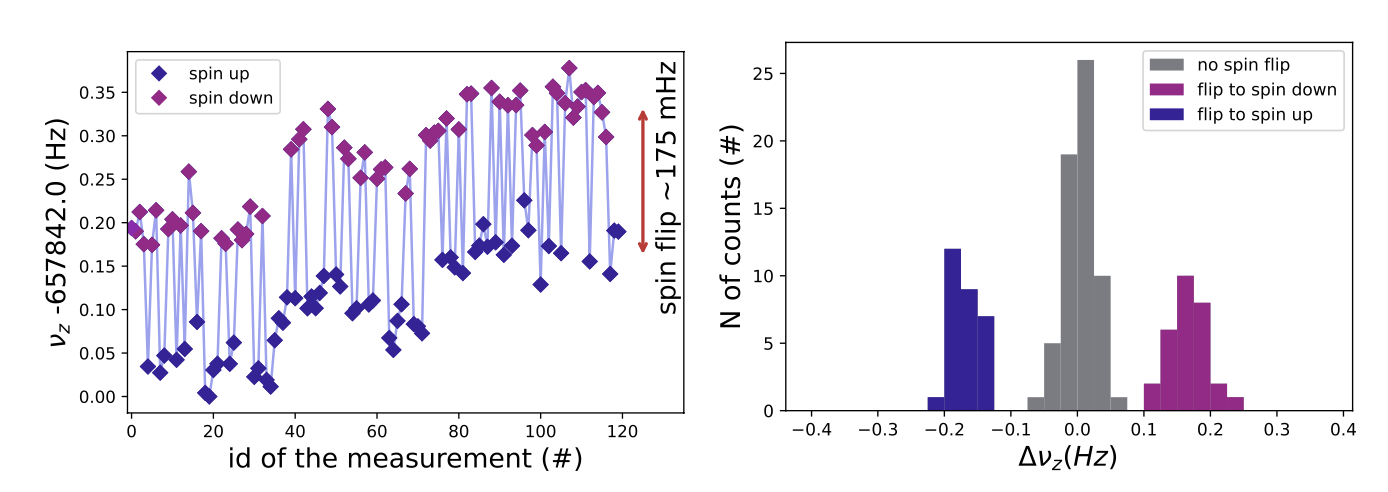Truly non-destructive: Antimatter under the microscope during the 2024-YETS

Early in the morning, on the 13th of November 2023, the AD/ELENA facility delivered its final antiproton bunch to the users at the antimatter factory. Most of the particles annihilated a few minutes later in antihydrogen formation and its spectroscopy, and most of the AD/ELENA users were shutting down their experiments. The fate of 30 antiprotons of the bunch delivered about 10500 shots earlier, on the 27th of October at 14:59, was very different from that of the other 3 × 1012 antiprotons provided to the AD/ELENA users in the 2023 run.
They were delivered to the safest place on earth for antimatter particles – the center of the reservoir trap of the Baryon/Antibaryon Symmetry Experiment (BASE) – where they still exist, at a temperature of 4.6 K and in a vacuum better than 10−18 mbar, continuously monitored by the resonant, non-destructive, superconducting particle detection systems used in the experiment. Since then, nine of the initial 30 got lost in trap commissioning experiments, see Figure 1 right, but since the 16th of December, counting from today 74 days ago, the remaining fraction – arguably the oldest 21 baryonic antimatter particles that currently exist on earth – remained stable in the multi-trap-stack of BASE. This offline operation mode – doing experiments when the CERN accelerator structure is in shutdown mode during the YETS – is essential for the high-precision comparisons of the fundamental properties of protons and antiprotons conducted at BASE. The considerably reduced magnetic field noise during the YETS reduces the required sampling time to achieve a certain fractional resolution in these measurements, typically at < 100 p.p.t.-level, by about a factor of 10.

Figure 1: Left: FFT of the superconducting resonator, with the trapped particles visible as a dip in the spectrum. Right: Reservoir dip line-width as a function of time, the steps correspond to particle extractions. The rise after 30 days corresponds to a change of the RT axial amplifier working point for additional noise suppression.
The BASE experimental setup consists of four Penning Traps in a hermetically sealed cryogenic vacuum chamber at ≈ 5K, as shown in Figure 2. This system is placed inside a B0 = 2T superconducting magnet. The antiprotons are injected into the Penning trap system through a 1760 nm thick window [2] that closes the trap-can, which maintains the extremely high vacuum required for lossless storage of antiprotons. In the current run, the estimated antiproton lifetime limit in the trap system is at 5.5 years [3]. The particles in the reservoir trap are oscillating and induce ≈ 10−15A image currents in the trap electrodes, which can be picked up by ultra-sensitive superconducting tuned circuits [4]. When particles are in thermal equilibrium with the detection circuit, they create a dip on the detector’s noise spectrum, as shown in Figure 1, left. The width of this dip scales with the number of trapped particles, and allows us to continuously and non-destructively monitor the trap content. The right plot in Figure 1 shows the dip width of the reservoir trap detector, over the course of four months, where the steps correspond to the deliberate extraction of particles. The right branch of the figure indicates that the trap content is stable for about 90 days. Since we have not detected any spontaneous loss due to annihilation, this enables us to estimate the hydrogen partial pressure to be smaller than pH < 1.2 × 10−18 mbar and the helium partial pressure to pHe < 2.2 × 10−18 mbar, pressures similar to those in the interstellar medium.

Figure 2: The BASE experiment Penning Trap system consists of four traps, including the Reservoir Trap, which stores antiprotons.
Currently, BASE is focusing on a ten-fold improved measurement of the antiproton magnetic moment in units of the nuclear magnetron, the so-called g-factor. This requires measuring the antiproton’s cyclotron frequency νc = (qB0)/(2πmp) and its spin precession frequency νL = (g/2)(qB0)/(2πmp). While νc is also determined by image-current-detection, the measurement of the spin precession frequency νL is an outstanding challenge. The concept of measuring νL relies on the application of non-destructive spin-quantum transition spectroscopy with a single antiproton. This is possible in the BASE analysis trap, which has a strong magnetic bottle superimposed that couples the particle’s magnetic moment to its axial oscillation frequency. In the ultra-stable trap that has cyclotron quantum heating rates on the order of one quantum jump per hour, a spin flip appears as a shift of the axial oscillation frequency. Once these spin transitions are made visible, the spin flips probability PSF is measured as a function of a resonant drive at frequency νrf applied to flip the spins in the precision trap, which features an ultrahomogeneous magnetic field. The resulting resonance PSF(νrf/νc) gives access to the antiproton g-factor.

Figure 3: Left: Axial frequency measurement of the particle in the Analysis Trap, with a spin flip induced between each measurement with a 50 % probability. Right: Histogram of the axial frequency shift for the same data set. On both plots, we observe a clear separation between an axial frequency corresponding to a particle changing its spin state from up to down and from down to up, resulting in a spin state identification error rate below 0.0005 %.
In the current annual accelerator shutdown, based on the antiprotons currently stored in the reservoir, we have achieved a world-record antiproton spin state detection fidelity, with an error rate of < 0.0005%. Results are shown in Fig. 3, left, where the axial frequency is measured as a function of time, while antiproton spin transitions are induced between the axial frequency measurements, from these measurements, the particle’s spin-state can be distinguished with 99.999 % detection fidelity. The right plot shows a histogram of the measured axial frequency differences, the lower and upper histograms indicate up/down and down/up flips, while in the central histograms events where no spin-flip occurred. By combining this high spin state identification fidelity in the analysis trap with spin flip spectrocopy in the precision trap our goal is to perform an antiproton g-factor measurement with 10 significant digits.
Acknowledgment: We express our profound gratitude for the outstanding assistance provided by the CERN groups, with special recognition extended to the AD operations team, the involved engineering departments, the HSE department, and the Cryolab.
